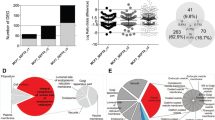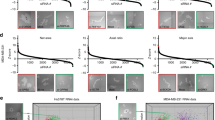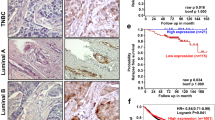Abstract
Gene expression reprogramming governs cellular processes such as proliferation, differentiation and cell migration through the complex and tightly regulated control of transcriptional cofactors that exist in multiprotein complexes. Here we describe SCAI (suppressor of cancer cell invasion), a novel and highly conserved protein that regulates invasive cell migration through three-dimensional matrices. SCAI acts on the RhoA–Dia1 signal transduction pathway and localizes in the nucleus, where it binds and inhibits the myocardin-related transcription factor MAL by forming a ternary complex with serum response factor (SRF). Genome-wide expression analysis surprisingly reveals that one of the strongest upregulated genes after suppression of SCAI is β1-integrin. Decreased levels of SCAI are tightly correlated with increased invasive cell migration, and SCAI is downregulated in several human tumours. Functional analysis of the β1-integrin gene strongly argues that SCAI is a novel transcriptional cofactor that controls gene expression downstream of Dia1 to dictate changes in cell invasive behaviour.
This is a preview of subscription content, access via your institution
Access options
Subscribe to this journal
Receive 12 print issues and online access
$209.00 per year
only $17.42 per issue
Buy this article
- Purchase on Springer Link
- Instant access to full article PDF
Prices may be subject to local taxes which are calculated during checkout








Similar content being viewed by others
Accession codes
References
Spiegelman, B. M. & Heinrich, R. Biological control through regulated transcriptional coactivators. Cell 119, 157–167 (2004).
Copeland, J. W. & Treisman, R. The diaphanous-related formin mDia1 controls serum response factor activity through its effects on actin polymerization. Mol. Biol. Cell 13, 4088–4099 (2002).
Faix, J. & Grosse, R. Staying in shape with formins. Dev. Cell 10, 693–706 (2006).
Grosse, R., Copeland, J. W., Newsome, T P., Way, M. & Treisman, R. A role for VASP in RhoA-Diaphanous signalling to actin dynamics and SRF activity. EMBO J. 22, 3050–3061 (2003).
Cen, B. et al. Megakaryoblastic leukemia 1, a potent transcriptional coactivator for serum response factor (SRF), is required for serum induction of SRF target genes. Mol. Cell. Biol. 23, 6597–6608 (2003).
Miralles, F., Posern, G., Zaromytidou, A. I. & Treisman, R. Actin dynamics control SRF activity by regulation of its coactivator MAL. Cell 113, 329–342 (2003).
Vartiainen, M. K., Guettler, S., Larijani, B. & Treisman, R. Nuclear actin regulates dynamic subcellular localization and activity of the SRF cofactor MAL. Science 316, 1749–1752 (2007).
Ma, Z. et al. Fusion of two novel genes, RBM15 and MKL1, in the t(1;22)(p13;q13) of acute megakaryoblastic leukemia. Nature Genet. 28, 220–221 (2001).
Mercher, T. et al. Involvement of a human gene related to the Drosophila spen gene in the recurrent t(1;22) translocation of acute megakaryocytic leukemia. Proc. Natl Acad. Sci. USA 98, 5776–5779 (2001).
Somogyi, K. & Rorth, P. Evidence for tension-based regulation of Drosophila MAL and SRF during invasive cell migration. Dev. Cell 7, 85–93 (2004).
Sahai, E. Mechanisms of cancer cell invasion. Curr. Opin. Genet. Dev. 15, 87–96 (2005).
DeMali, K. A., Wennerberg, K. & Burridge, K. Integrin signaling to the actin cytoskeleton. Curr. Opin. Cell Biol. 15, 572–582 (2003).
Hynes, R. O. Integrins: bidirectional, allosteric signaling machines. Cell 110, 673–687 (2002).
Brakebusch, C., Bouvard, D., Stanchi, F., Sakai, T. & Fassler, R. Integrins in invasive growth. J. Clin. Invest. 109, 999–1006 (2002).
Caswell, P. T. et al. Rab25 associates with α5β1-integrin to promote invasive migration in 3D microenvironments. Dev Cell 13, 496–510 (2007).
Brakebusch, C. & Fassler, R. β1-integrin function in vivo: adhesion, migration and more. Cancer Metastasis Rev. 24, 403–411 (2005).
Wang, W. et al. Identification and testing of a gene expression signature of invasive carcinoma cells within primary mammary tumors. Cancer Res 64, 8585–8594 (2004).
White, D. E. et al. Targeted disruption of β1-integrin in a transgenic mouse model of human breast cancer reveals an essential role in mammary tumor induction. Cancer Cell 6, 159–170 (2004).
Yao, E. S. et al. Increased β1-integrin is associated with decreased survival in invasive breast cancer. Cancer Res. 67, 659–664 (2007).
Brandt, D. T. et al. Dia1 and IQGAP1 interact in cell migration and phagocytic cup formation. J. Cell Biol. 178, 193–200 (2007).
Zaromytidou, A.-I., Miralles, F. & Treisman, R. MAL and Ternary Complex Factor use different mechanisms to contact a common surface on the Serum Response Factor DNA-binding domain. Mol. Cell. Biol. 26, 4134–4148 (2006).
Liu, Z. P., Wang, Z., Yanagisawa, H. & Olson, E. N. Phenotypic modulation of smooth muscle cells through interaction of Foxo4 and myocardin. Dev. Cell 9, 261–270 (2005).
Kitzing, T. M. et al. Positive feedback between Dia1, LARG, and RhoA regulates cell morphology and invasion. Genes Dev. 21, 1478–1483 (2007).
Wolf, K. et al. Compensation mechanism in tumor cell migration: mesenchymal-amoeboid transition after blocking of pericellular proteolysis. J. Cell Biol. 160, 267–277 (2003).
Spessotto, P. et al. β1-Integrin-dependent cell adhesion to EMILIN-1 is mediated by the gC1q domain. J. Biol. Chem. 278, 6160–6167 (2003).
Medjkane, S., Perez-Sanchez, C., Gaggioli, C., Sahai, E. & Treisman, R. Myocardin-related transcription factors and SRF are required for cytoskeleton dynamics and experimental metastasis. Nature Cell Biol. 11, 257–268 (2009).
Padua, D. et al. TGFβ primes breast tumors for lung metastasis seeding through angiopoietin-like 4. Cell 133, 66–77 (2008).
Carreira, S. et al. Mitf regulation of Dia1 controls melanoma proliferation and invasiveness. Genes Dev. 20, 3426–3439 (2006).
Phair, R. D. & Misteli, T. High mobility of proteins in the mammalian cell nucleus. Nature 404, 604–609 (2000).
Freddie, C. T., Ji, Z., Marais, A. & Sharrocks, A. D. Functional interactions between the Forkhead transcription factor FOXK1 and the MADS-box protein SRF. Nucleic Acids Res. 35, 5203–5212 (2007).
Worzfeld, T., Puschel, A. W., Offermanns, S. & Kuner, R. Plexin-B family members demonstrate non-redundant expression patterns in the developing mouse nervous system: an anatomical basis for morphogenetic effects of Sema4D during development. Eur J. Neurosci. 19, 2622–2632 (2004).
Saeed, A. I. et al. TM4: a free, open-source system for microarray data management and analysis. BioTechniques 34, 374–378 (2003).
Acknowledgements
We thank B. Di Ventura and W. Birchmeier for critical reading, and R. Treisman and T. Worzfeld for stimulating discussions. We are grateful to A. Ripperger, K. Reeck and G. Streichert for technical assistance, and U. Engel at the Nikon Imaging Center for imaging advice. This work was funded by the Emmy Noether Program of the Deutsche Forschungsgemeinschaft (GR 2111/1-3) and the Wilhelm Sander-Stiftung (2008.020.1) to R.G. R.G. is a member of the excellence cluster Cellular Networks and supported by the CHS Foundation. J.I. is supported by the EMBO Young Investigator Program, Academy of Finland, and the European Research Council.
Author information
Authors and Affiliations
Contributions
D.T.B. and C.B. designed, performed and analysed the majority of experiments; T.M.K. generated data in Figs 6 and 7. E.K. generated monoclonal antibodies against SCAI; J.I. generated the data in Fig. 7d, and P.N. the data in Fig. 7a. R.G. generated data in Fig. 5, designed and discussed experiments and wrote the manuscript.
Corresponding author
Ethics declarations
Competing interests
The authors declare no competing financial interests.
Supplementary information
Supplementary Information
Supplementary Information (PDF 1131 kb)
Supplementary Information
Supplementary Table 1 (XLS 110 kb)
Rights and permissions
About this article
Cite this article
Brandt, D., Baarlink, C., Kitzing, T. et al. SCAI acts as a suppressor of cancer cell invasion through the transcriptional control of β1-integrin. Nat Cell Biol 11, 557–568 (2009). https://doi.org/10.1038/ncb1862
Received:
Accepted:
Published:
Issue Date:
DOI: https://doi.org/10.1038/ncb1862
This article is cited by
-
A review on the biological roles of LncRNA PTCSC3 in cancerous and non-cancerous disorders
Cancer Cell International (2023)
-
Hsa_circ_0052611 and mir-767-5p guide the warburg effect, migration, and invasion of BRCA cells through modulating SCAI
Journal of Bioenergetics and Biomembranes (2023)
-
MicroRNAs as the critical regulators of cell migration and invasion in thyroid cancer
Biomarker Research (2022)
-
Mechanical stress shapes the cancer cell response to neddylation inhibition
Journal of Experimental & Clinical Cancer Research (2022)
-
Phosphorylation of MICAL2 by ARG promotes head and neck cancer tumorigenesis by regulating skeletal rearrangement
Oncogene (2022)



